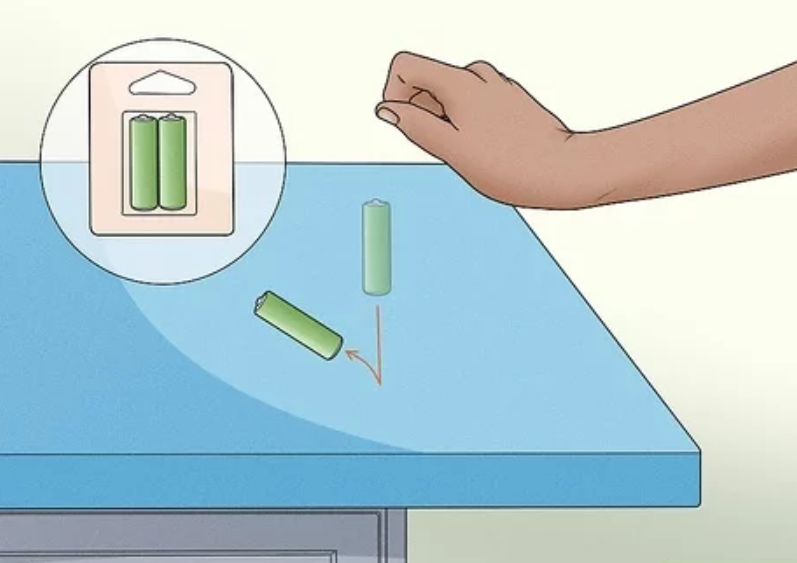In today’s fast-paced world, where smartphones and gadgets dominate our lives, it’s easy to forget some of the simple yet effective tricks that have been passed down through generations. These old-school tips might seem outdated, but they often provide a reliable backup when technology fails us. Whether it’s figuring out how many days are in a month or remembering tricky spelling rules, these 10 tips are as relevant today as they were decades ago.
1. How to Test If a Battery Is Good or Bad

Have you ever found a loose battery lying around and wondered if it’s still usable? Here’s a quick and simple trick to check. Drop the battery onto a flat, hard surface from about one or two centimeters in the air. If the battery bounces and falls over, it’s likely a dud. If it lands upright, it’s still good to go! This trick is especially handy when you’re in a pinch and don’t have a battery tester on hand.
2. Finding South Without a Compass
Getting lost without a compass or a smartphone can be nerve-wracking, but there’s an old-school method to find your way. If you have an analog watch and can see the sun, you’re in luck. Place the watch flat on your palm with the hour hand pointing toward the sun. Then, place a toothpick or a blade of grass across the face of the watch, aligning it between the hour hand and the 12 o’clock mark. The end of the toothpick or grass that’s closest to the 12 should be pointing due south. This trick can be a lifesaver in the great outdoors.
3. Remembering Roman Numeral Values
Roman numerals can be tricky, especially when you move beyond the basics of I, V, and X. To remember the values of these ancient numbers, use this mnemonic device: “My Dear Cat Loves Xtra Vitamins Intensely.” The first letter of each word corresponds to a Roman numeral, listed in descending order from 1,000 to 1:
- M (1,000)
- D (500)
- C (100)
- L (50)
- X (10)
- V (5)
- I (1)
This phrase is a fun and easy way to keep those Roman numerals straight in your head.
4. Multiplying by 11 Made Easy

Multiplication tables can be challenging, but there’s an old-school trick that makes multiplying by 11 a breeze. For any number from 1 to 9, just double the number to find the result of multiplying it by 11. For example:
- 2 x 11 = 22
- 4 x 11 = 44
- 7 x 11 = 77
This simple trick is a great way to build confidence in young learners and make math a little less daunting.
5. Waxing and Waning Moon: How to Tell the Difference
The moon’s phases can be confusing, especially when trying to distinguish between waxing (growing) and waning (shrinking). Here’s an easy way to remember: The waning moon looks like a “C,” while the waxing moon looks like a “D.” This visual cue helps you quickly determine whether the moon is getting fuller or thinner.
6. Spelling Rule: “I Before E, Except After C”
English spelling can be tricky, but this classic rule helps with words that contain “ie” or “ei.” The rule goes: “I before E, except after C; and in words that say A as in neighbor and weigh.” While there are exceptions to this rule, it’s a helpful guideline for getting most spellings correct.
7. Estimating Time Until Sunset

If you’re outdoors and need to estimate how much daylight is left before sunset, here’s a handy trick. Hold your hand out at arm’s length with your fingers stacked horizontally under the sun. Count how many fingers fit between the sun and the horizon. Each finger represents about 15 minutes of daylight remaining. This method is surprisingly accurate and can help you plan your activities before darkness falls.
8. Disinfecting Sponges and Cloths
Kitchen sponges and cloths can harbor bacteria, but there’s an old-school method to disinfect them effectively. Simply boil the sponge or cloth in water for 10 minutes. This process kills most germs and leaves your cleaning tools fresh and ready for use. It’s a simple yet effective way to keep your kitchen hygienic.
9. Remembering Which Months Have 31 Days
Need to remember how many days are in each month? There are two classic methods to help you out. First, you can use the knuckle trick: Start with the knuckle of your forefinger as January, the valley between knuckles as February, and so on. The knuckles represent months with 31 days, while the valleys represent months with 30 days (except for February, of course). Alternatively, you can memorize this rhyme: “Thirty days hath September, April, June, and November. All the rest have 31.” Both methods are simple and effective.
10. Using Your Hand to Measure Angles

If you ever need to estimate angles quickly, your hand can serve as a useful tool. By holding your hand up and forming a 90-degree angle from your thumb to your pinkie, you can measure angles with ease. Spread your fingers slightly to estimate:
- Pinkie to ring finger: 30 degrees
- Pinkie to middle finger: 45 degrees
- Pinkie to forefinger: 60 degrees
This method is particularly useful in situations where precision instruments aren’t available.
Conclusion: The Timeless Value of Old-School Tips
In a world where technology often reigns supreme, these old-school tips and tricks remind us of the power of simplicity. While smartphones and gadgets are incredibly useful, they’re not always available or reliable. By keeping these timeless tips in mind, you’ll be prepared to handle a variety of everyday challenges, even when the batteries run out or the signal drops. Embrace the wisdom of the past, and you’ll find that life can be just a little bit easier.


